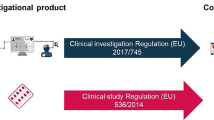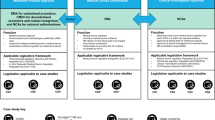Abstract
During the last few years, the pharmaceutical industry has adopted digital technologies/digital health technology (DHT) to improve the drug development process and the commercialization of new products. Technological advances are strongly supported by both the US-FDA and the EMA, but the regulatory landscape in the US seems to be more suitable to promote innovation in the digital health sector (e.g. Cures Act). In contrast, the new Medical Device Regulation sets high hurdles for Medical Device software to pass regulatory scrutiny.
On both sides of the Atlantic, a digital tool must be fit-for-purpose for the intended use in the clinical drug trial. Irrespective of its status as a Medical Device, at least the basic safety and performance requirements according to local regulations should be met, quality system and surveillance requirements should be fulfilled, and the sponsor must ensure conformity with GxP and the local data privacy and cybersecurity legislations.
There is an overlap in technical and clinical validation for drug development tool qualification in both regions to ensure that the digital tools deliver reliable data with tangible clinical benefits. Based on an analysis of the regulatory framework of the FDA and the EMA, this study proposes regulatory strategies for a global pharma company: It would be prudent for drug development companies to a) use approved solutions or b) consider qualification of drug development tools early and in parallel to clinical development. Early engagement with the FDA and the EMA/CA is recommended to define evidentiary standards and corresponding regulatory pathways for different contexts-of-use and to clarify regulator’s expectations as to what extent data collected by digital tools are acceptable to support marketing authorization applications (MAA).
Hence a harmonization of the partly disparate regulatory requirements in the US and the EU accompanied by further development of the regulatory landscape in the EU, could further foster the use of digital tools in drug clinical development. The outlook for the use of digital tools in clinical trials is hopeful.






Similar content being viewed by others
Data Availability
All data supporting the findings of this study are available within the paper and its Supplementary Information, via the links as provided in the reference section.
References
Kim BY, Lee J. Smart devices for older adults managing chronic disease: a scoping review. JMIR Mhealth Uhealth. 2017;5:e69.
Cornet VP, Holden RJ. Systematic review of smartphone-based passive sensing for health and wellbeing. J Biomed Inform. 2018;77:120–32.
Fedele DA, Cushing CC, Fritz A, et al. Mobile health interventions for improving health outcomes in youth: a metaanalysis. JAMA Pediatr. 2017;171:461–9.
Cortez NG, Cohen IG, Kesselheim AS. FDA regulation of mobile health technologies. N Engl J Med. 2014;371:372–9.
Topol EJ, Steinhubl SR, Torkamani A. Digital medical tools and sensors. JAMA. 2015;313:353–4.
European Commission, the Heads of Medicines Agencies and the European Medicines Agency. Recommendation paper on decentralised elements in clinical trials. Version 01, 13 December 2022.
Kramer F, Sabbah HN, Januzzi JJ, et al. Redefining the role of biomarkers in heart failure trials: expert consensus document. Heart Fail Rev. 2017;22:263–77.
Clinical Trial Transformation Initiative. Official recommendations: developing novel endpoints generated by mobile technology for use in clinical trials. Developing Novel Endpoints - CTTI (ctti-clinicaltrials.org). Accessed 23 March 2023.
Clinical Trial Transformation Initiative. Official Recommendations. https://www.ctti-clinicaltrials.org/briefing-room/recommendations. Accessed 23 March 2023.
Goldsack JC, Coravos A, Bakker JP, et al. Verification, analytical validation, and clinical validation (V3): the foundation of determining fit-for-purpose for Biometric Monitoring Technologies (BioMeTs). Npj Digit Med. 2020;3:55.
Fryback DG, Thornbury JR. The efficacy of diagnostic imaging. Med Decis Making. 1991;11(2):88–94.
Karakoyun T, Podhaisky H, Frenz A, et al. A digital medical device companion (MyIUS) for new users of intrauterine systems: App development study. JMIR Med Inform. 2021;9(7):e24633.
Izmailova ES, Wagner JA, Perakslis ED. Wearable devices in clinical trials: hype and hypothesis. Clin Pharmacol Ther. 2018;104(1):42–52.
Marquis-Gravel G, Roe MT, Turakhia MP, et al. Technology-enabled clinical trials. Circulation. 2019;140:1426–36.
Elenko E, Speier A, Zohar D. A regulatory framework emerges for digital medicine. Nat Biotechnol. 2015;33(7):697–702.
Marra C, Chen JL, Coravos A, et al. Quantifying the use of connected digital products in clinical research. Npj Digit Med. 2020;3(1):50.
US Title 21 Code of Federal Regulations (CFR). https://www.accessdata.fda.gov/scripts/cdrh/cfdocs/cfcfr/CFRSearch.cfm
EMA. Qualification of novel methodologies for drug development: guidance to applicants. EMA/CHMP/SAWP/72894/2008. November 2014. https://www.ema.europa.eu/en/documents/regulatory-procedural-guideline/qualification-novel-methodologies-drug-development-guidance-applicants_en.pdf
FDA. Qualification Process for Drug Development Tools - Draft Guidance for Industry and FDA Staff. November 2020. https://www.fda.gov/media/133511/download
FDA-NIH Biomarker Working Group. BEST (Biomarkers, EndpointS, and other Tools) Resource. Silver Spring, MD: Food and Drug Administration [US]; Bethesda, MD: National Institutes of Health [US]. https://www.ncbi.nlm.nih.gov/books/NBK326791/ Accessed 23 March 2023.
EMA. Questions and answers: Qualification of digital technology-based methodologies to support approval of medicinal products. EMA/219860/2020. June 2020. https://www.ema.europa.eu/en/documents/other/questions-answers-qualification-digital-technology-based-methodologies-support-approval-medicinal_en.pdf
FDA Patient-Focused Drug Development: Collecting Comprehensive and Representative Input - Guidance for Industry, Food and Drug Administration Staff, and Other Stakeholders. June 2020 https://www.fda.gov/media/139088/download
Vasudevan S, Saha A, Tarver ME, et al. Digital biomarkers: Convergence of digital health technologies and biomarkers. NPJ Digit Med. 2022;5(1):36.
FDA. Clinical Outcome Assessment (COA) Qualification Program: Frequently Asked Questions. https://www.fda.gov/drugs/drug-development-tool-ddt-qualification-programs/clinical-outcome-assessment-coa-qualification-program-frequently-asked-questions#AmIRequredToUSeONLY Accessed 23 March 2023.
FDA Patient-Focused Drug Development: Selecting, Developing, or Modifying Fit-for-Purpose Clinical Outcome Assessments - Draft Guidance for Industry, Food and Drug Administration Staff, and Other Stakeholders. June 2022 https://www.fda.gov/media/159500/download
ICH guideline E6 on good clinical practice - Draft ICH E6 principles. EMA/CHMP/ICH/337843/2021 24 June 2021 https://www.ema.europa.eu/en/documents/scientific-guideline/ich-guideline-e6-good-clinical-practice-draft-ich-e6-principles_en.pdf
US Title 45 Code of Federal Regulations (CFR) Part 160 and Part 164, Subparts A and C. https://www.ecfr.gov/current/title-45/subtitle-A/subchapter-C/part-160?toc=1
FDA. Electromagnetic Compatibility (EMC) of Medical Devices Guidance for Industry and Food and Drug Administration Staff. June 2022.https://www.fda.gov/media/94758/download
FDA. Radio Frequency Wireless Technology in Medical Devices - Guidance for Industry and Food and Drug Administration Staff. August 2013. https://www.fda.gov/media/71975/download
FDA. Digital Health Policy Navigator, https://www.fda.gov/medical-devices/digital-health-center-excellence/digital-health-policy-navigator. Accessed 23 March 2023.
Regulation (EU) 2017/745 of the European Parliament and of the Council of 5 April 2017 on medical devices, amending Directive 2001/83/EC, Regulation (EC) No 178/2002 and Regulation (EC) No 1223/2009 and repealing Council Directives 90/385/EEC and 93/42/EEC https://eur-lex.europa.eu/eli/reg/2017/745/oj
Regulation (EU) 2016/679 of the European Parliament and of the Council of 27 April 2016 on the protection of natural persons with regard to the processing of personal data and on the free movement of such data, and repealing Directive 95/46/EC (General Data Protection Regulation) https://eur-lex.europa.eu/eli/reg/2016/679/oj
Directive (EU) 2016/1148 of the European Parliament and of the Council of 6 July 2016 concerning measures for a high common level of security of network and information systems across the Union https://eur-lex.europa.eu/eli/dir/2016/1148/oj
Regulation (EU) 2019/881 of the European Parliament and of the Council of 17 April 2019 on ENISA (the European Union Agency for Cybersecurity) and on information and communications technology cybersecurity certification and repealing Regulation (EU) No 526/2013 (Cybersecurity Act) https://eur-lex.europa.eu/eli/reg/2019/881/oj
Directive 2014/30/EU of the European Parliament and of the Council of 26 February 2014 on the harmonisation of the laws of the Member States relating to electromagnetic compatibility https://eur-lex.europa.eu/eli/dir/2014/30/oj
Dashiell-Aje E, Kovacs S, Sacks L. Regulatory Perspective: Digital Health Technology Tools - Use in Clinical Investigations to Evaluate Clinical Benefit in Patients. DIA Global Forum. June 2019
Leptak C. Regulatory Guidance and Evidentiary Criteria for Drug Development Tools. Biomarkers Consortium - Workshop: Remote Digital Monitoring for Medical Product Development. 18–19 February 2020. https://fnih.org/sites/default/files/final/pdf/2%20-%20Leptak_Reg%20Guidance%20DDT.pdf. Accessed 23 March 2023.
FDA. Innovative Science and Technology Approaches for New Drugs (ISTAND) Pilot Program. 2 October 2021. https://www.fda.gov/drugs/drug-development-tool-ddt-qualification-programs/innovative-science-and-technology-approaches-new-drugs-istand-pilot-program. Accessed 23 March 2023.
FDA. Patient-Reported Outcome Measures: Use in Medical Product Development to Support Labeling Claims - Guidance for Industry. December 2009. https://www.fda.gov/media/77832/download
FDA. Significant Risk and Nonsignificant Risk Medical Device Studies - Information Sheet Guidance For IRBs, Clinical Investigators, and Sponsors. January 2006 https://www.fda.gov/media/75459/download
The European Commission. Horizon 2020. https://ec.europa.eu/programmes/horizon2020/en/what-horizon-2020. Accessed 23 March 2023.
Innovative Medicines Initiative. https://www.imi.europa.eu/. Accessed 23 March 2023.
Cerreta F. EMA experience with the review of digital technology proposals in medicine development programmes. 3rd Industry Stakeholder Platform on R&D support. 18 May 2018 https://www.ema.europa.eu/en/documents/presentation/presentation-ema-experience-review-digital-technology-proposals-medicine-development-programmes_en.pdf
Cerreta F. Important considerations for successful qualification proposals for digital technologies. Industry Stakeholder Platform on R&D support. November 2018. https://www.ema.europa.eu/en/documents/presentation/presentation-important-considerations-successful-qualification-proposals-digital-technologies-f_en.pdf
Cerreta F, Ritzhaupt A, Metcalfe T, et al. Digital technologies for medicines: shaping a framework for success. Nat Rev Drug Discov. 2020;19:573–4.
Manta C, Patrick-LAe B, Goldsack JC. Digital measures that matter to patients: a framework to guide the selection and development of digital measures of health. Digit Biomark. 2020;4(3):69–77.
Kruizinga MD, Stuurman FE, Exadaktylos V, et al. Development of novel, value-based, digital endpoints for clinical trials: a structured approach toward fit-for-purpose validation. Pharmacol Rev. 2020;72(4):899–909.
Walton MK, Cppelleri JC, Byrom B, et al. Considerations for development of an evidence dossier to support the use of mobile sensor technology for clinical outcome assessments in clinical trials. Contemp Clin Trials. 2020;90: 105962.
Geoghegan C, Nido V, Botto-van Bemden A, et al. Learning from patient and site perspectives to develop better digital health trials: Recommendations from the Clinical Trials Transformation Initiative. Contemp Clin. 2020;19: 100636.
FDA Digital Health Technologies for Remote Data Acquisition in Clinical Investigations - Draft Guidance for Industry, Investigators, and Other Stakeholders. January 2022 https://www.fda.gov/media/155022/download
Torous J, Stern AD, Bourgeois FT. Regulatory considerations to keep pace with innovation in digital health products. NPJ Digit Med. 2022;5(1):121.
EFPIA Reflection Paper on the Need for Better Defined Regulatory Pathways in the EU for Digital Health Technologies used concomitantly with Medicinal Products or as drug development tools during Clinical Development, November 2021. https://www.efpia.eu/media/636454/efpia-rp-digital-health-technologies_november-2021.pdf
MDCG 2021–6. Regulation (EU) 2017/745 – Questions & Answers regarding clinical investigation. April 2021. https://health.ec.europa.eu/system/files/2021-04/mdcg_2021-6_en_0.pdf
EMA Draft guideline on computerised systems and electronic data in clinical trials. EMA/226170/2021. June 2021 https://www.ema.europa.eu/en/documents/regulatory-procedural-guideline/draft-guideline-computerised-systems-electronic-data-clinical-trials_en.pdf
EMA. Qualification opinion on stride velocity 95th centile as a secondary endpoint in Duchenne Muscular Dystrophy measured by a valid and suitable wearable device. EMA/CHMP/SAWP/178058/2019. April 2019. https://www.ema.europa.eu/en/documents/scientific-guideline/qualification-opinion-stride-velocity-95th-centile-secondary-endpoint-duchenne-muscular-dystrophy_en.pdf
Human Factors Studies and Related Clinical Study Considerations in Combination Product Design and Development - Draft Guidance for Industry and FDA Staff. February 2016. https://www.fda.gov/media/96018/download
PhRMA. Outputs from PhRMA Digital Health Sub-Teams - Working draft. September 2019.
MOBILISE-D Homepage. https://www.mobilise-d.eu/ Accessed 23 March 2023.
EMA. Recommendation paper on decentralized elements in clinical trials. December 2022 https://health.ec.europa.eu/system/files/2023-03/mp_decentralised-elements_clinical-trials_rec_en.pdf
EMA. Accelerating Clinical Trials in the EU (ACT EU) multi-annual Workplan 2022–2026 https://www.ema.europa.eu/en/documents/other/act-eu-multi-annual-workplan-2022-2026_en.pdf
FDA Framework for the Use of Digital Health Technologies in Drug and Biological Product Development. March 2023 https://www.fda.gov/media/166396/download
Funding
No financial support was received for the research, authorship, and/or publication of this article. The authors would like to thank Amy Bertha (Research & Development, Pharmaceuticals, Regulatory Affairs, Bayer AG) and Dr. Gerardine Burton (Research & Development, Pharmaceuticals, Regulatory Affairs, Bayer AG) for the support in writing the article.
Author information
Authors and Affiliations
Contributions
All authors contributed to the design of the work, the data acquisition, its interpretation, and manuscript revision, and they have read and approved the submitted version.
Corresponding author
Ethics declarations
Conflict of interest
The authors of this publication declare no conflict of interest. The views expressed in this article are the personal views of the authors and may not be understood or quoted as being made on behalf of or reflecting the position of company which the authors are affiliated. All authors are currently employed by Bayer AG.
Additional information
Publisher's Note
Springer Nature remains neutral with regard to jurisdictional claims in published maps and institutional affiliations.
Supplementary Information
Below is the link to the electronic supplementary material.
Rights and permissions
Springer Nature or its licensor (e.g. a society or other partner) holds exclusive rights to this article under a publishing agreement with the author(s) or other rightsholder(s); author self-archiving of the accepted manuscript version of this article is solely governed by the terms of such publishing agreement and applicable law.
About this article
Cite this article
Gelis, L., Stoeckert, I. & Podhaisky, HP. Digital Tools—Regulatory Considerations for Application in Clinical Trials. Ther Innov Regul Sci 57, 769–782 (2023). https://doi.org/10.1007/s43441-023-00535-z
Received:
Accepted:
Published:
Issue Date:
DOI: https://doi.org/10.1007/s43441-023-00535-z




